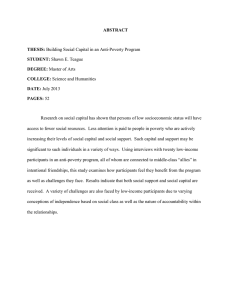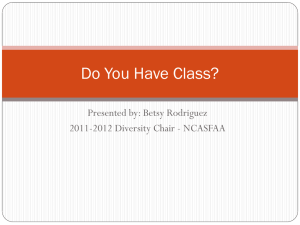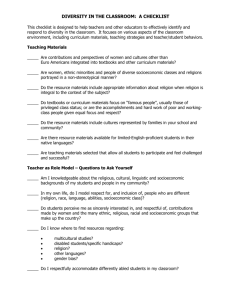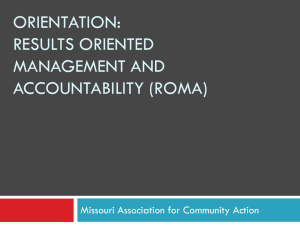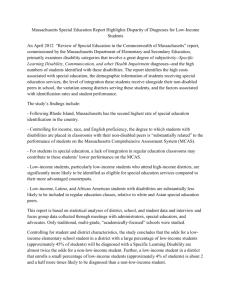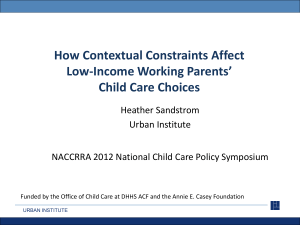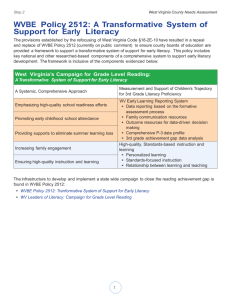Social Class
advertisement
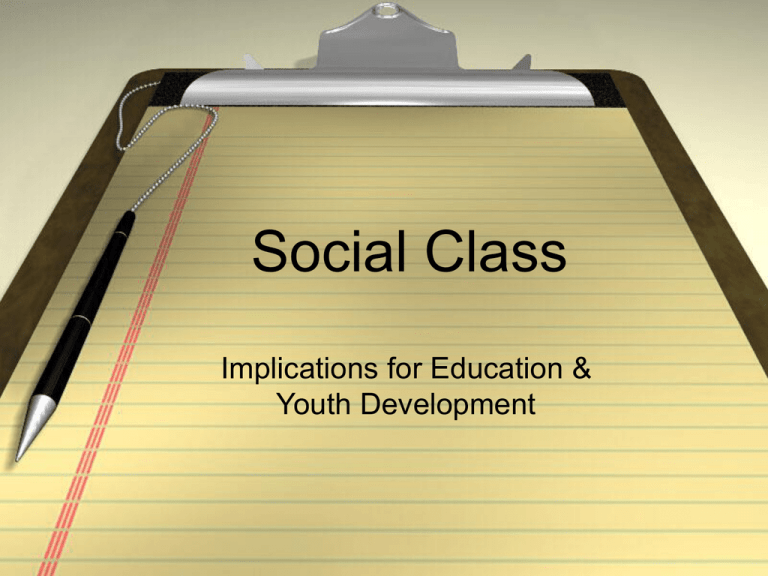
Social Class Implications for Education & Youth Development Examining Social Class Interactive Social Class exercise How do we define and recognize social class? What assumptions do you have with regard to social class? Questions to consider… Please consider the following questions throughout the presentation… How do you perceive your own social class? How do you think your students perceive your social class? What implications does this have for your work? How do societal assumptions about class impact your students? Can social class develop independently in a closed setting such as a classroom? Can a person of low status/rank from one setting have a high status or rank in a different setting or vice versa? Does a classroom or program develop its own social classification? If so, which is it more important to be sensitive to; in-class, in society, or both? How should social class be addressed in the classroom? What do teachers need to be aware of in order to best serve students of various social classes? Defining Class Based on our discussion of the definition and perceptions of class, what class do you believe you fit into? Class Matters: A New York Times feature from 2005. Exercise: Where you fit on the spectrum. How do you think students perceive your social class? What implications does this have for your work? Societal Perceptions of Class How are our definitions of social class shaped by societal influences? “Class Dismissed” Video How do societal assumptions about class, and associated portrayal in the media, impact you and your students? Impacts… …of Education on Socioeconomic Class …of Socioeconomic Class on Education …of Education on Class Revisiting “Class Matters” Income as a major factor in social class (Socioeconomic class). Education: Impact on Income Income: Impact on Class Mobility …of Class on Education “It is difficult to isolate the factors that may produce a given effect simply by comparing middle-class to working-class children. Social class is a "package variable"--a summary label for an intricate complex of related variables including parental education, occupational status, income, housing conditions, time allocation, attitudes toward school and schooling, experiences with school, expectations for future educational and occupational success, nature of the family's social network, style of parent-child interaction, and many more elements. Replicating findings of social class differences in school achievement brings us no closer to understanding the mechanisms by which those differences develop because it is rarely possible to sort out the separate effects of the wide array of factors packaged together as "working class" or "middle class.” Snow, Catherine., Tabors, Patton. (1996). Intergenerational Transfer of Literacy. Family Literacy. Retrieved November, 2008. http://www.ed.gov/pubs/FamLit/transfer.html of Class on Education… “Taking all ethnic groups and genders, low-SES students drop out six times as often as high-SES students and almost three times as much as mid-SES students.” Van Galen, Jane., Noblit, George., Apple, Michael. (2007) Late to Class: Social Class and Schooling in the New Economy. Excerpt obtained from Google Books. Looking at a few examples… Literacy Student Performance Higher Education “The needs of low-income students may be overlooked because of the relative invisibility of this risk factor in comparison with others based on race, gender, or disability.” Duffy, Jennifer O. (2007). Invisibly at Risk: Low-income Students in a Middle and Upper-Class World. About Campus, Volume 12, Issue 7. Retrieved via Academic Search Premier. Literacy “High performance on standardized tests of reading is consistently associated with access to print, and that children of poverty have far less access to print. This relationship holds because access to print results in more recreational reading, and more recreational reading results in more literacy development. The obvious part of the cure for children of poverty is more access to print, via better school and public libraries.” Have you noticed instances in your class of students from different socioeconomic classes having differing access to reading materials? Krashen, Stephen. (2005). The Hard Work Hypothesis: Is Doing your Homework Enough to Overcome the Effects of Poverty. Multicultural Education, v12, n4. Retreived October 2008, fromhttp://eric.ed.gov/ERICWebPortal/ Student Performance US Dept of Ed: http://nces.ed.gov/pubs2004/pirlspub/9.asp?nav=2 Student Performance NCES: The Condition of Education 2006: Poverty & Student Mathematics Achievement http://nces.ed.gov/programs/coe/2006/section2/indicator15.asp Higher Education “In their contribution to the book Condition of Access, Brian Fitzgerald and Jennifer Delaney reveal that nationwide, within five years of entering college, more than 40 percent of students from the top income quartile graduate with a bachelor’s degree, compared with 6 percent from the lowest income quartile. These low graduation rates for low-income students can be attributed to academic and social struggles unique to this population that act as barriers to their success.” Duffy, Jennifer O. (2007). Invisibly at Risk: Low-income Students in a Middle and Upper-Class World. About Campus, Volume 12, Issue 7. Retrieved via Academic Search Premier. Higher Education “Access and financial support do not necessarily lead to success for low-income students; such policies must be coupled with a range of other support systems aimed at ensuring that students enroll and graduate.” “Working class students are less likely to attend graduate school than more affluent students who graduated with the same grades from the same institutions.” Duffy, Jennifer O. (2007). Invisibly at Risk: Low-income Students in a Middle and Upper-Class World. About Campus, Volume 12, Issue 7. Retrieved via Academic Search Premier. Have you noticed differences in the aspirations of students from different socioeconomic backgrounds? Pedagogical Implications Advice from the : Derek Bok Center for Teaching and Learning Harvard University http://isites.harvard.edu/fs/html/icb.topic58474/class.html Be very explicit about classroom norms and rules of operation. Let students know how to play the game, and help those who seem uncertain. Include readings from a wide variety of class perspectives. Use examples that come from every class. Acknowledge class differences and make class a topic for discussion. Look for class-based perspectives. Note valueladen language. Ask about student experience and about personal reactions to material; include these in content discussions. More advice from the : Derek Bok Center for Teaching and Learning Harvard University Get to know your students and their individual strengths and weaknesses. Teach to both. Vary the kinds of assignments, to include a variety of learning styles. Vary classroom activities, to include collaboration and small group work. Provide the opportunity for rewriting papers, as a way to teach students still learning to work in that mode. Protect the student who makes an unsophisticated comment. Model the acceptance of various class backgrounds. Change-making… Educate yourself Know your youth Know class and cultural boundaries and customs Know local resources Work to diminish the gaps in your class/group Identify barriers that keep students from learning Look to develop social capital (How do you define social capital?) Help students and their families access resources Legitimate Group/Classroom democracy Change-making Open an ongoing discussion on social class Be sensitive, but honest Allow time Let students direct the discussion Change and develop your curriculum where necessary Integrate student input and suggestions for change “Play Jazz” Use backdoors and tangents (I.e manners, customs, etc.) Online resource… People Like Us: A PBS Special www.pbs.org/peoplelikeus Further questions to consider… Have you ever done activities related to class with students or youth? If so, what did you do, and how did it go? How does class impact or influence your teaching overall? Is class an “invisible risk?” Can social class develop independently in a closed setting such as a classroom? Can a person of low status/rank from one setting have a high status or rank in a different setting or vice versa? Does a classroom or program develop its own social classification? If so, which is it more important to be sensitive to; in-class, in society, or both?
